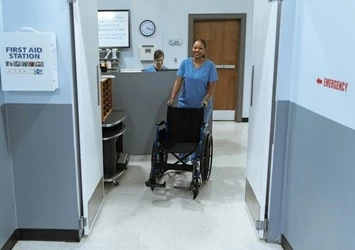Manchester University NHS Foundation Trust uses digital twin to drive transformation
3D digital twin model spans 274,000 square meters of internal floor space
Add bookmark
Manchester University NHS Foundation Trust (MFT) has gone live with a digital twin of six hospitals as part of its strategy to create a smart estate and support digital transformation.
Created using Esri UK’s GIS platform and delivering a single, reliable source of estates data, the 3D model marks a major milestone in MFT’s transformation by enabling new workflows and more informed decision-making to enhance operational efficiency and patient safety.
Replacing multiple disconnected systems and paper-based processes, the digital twin visualizes floors, rooms, and spaces alongside their associated data. It is already supporting space optimization and the management of RAAC and asbestos. Future developments include integrating indoor navigation, patient contact tracing, and real-time asset tracking.
Spanning 274,000 square meters of internal floor space, the 3D model includes Manchester Royal Infirmary, Royal Manchester Children's Hospital, Manchester Royal Eye Hospital, and Saint Mary's Hospital, plus Altrincham Hospital and Withington Community Hospital.
Join the PEX Network community

Don't miss any news, updates or insider tips from PEX Network by getting them delivered to your inbox. Sign up to our newsletter and join our community of experts.
Learn MoreHow a digital twin is driving NHS transformation
“The deployment of the digital twin at Manchester Foundation Trust marks a pivotal shift from fragmented, paper-based systems to a unified digital platform,” said Kay Mulcahy, associate director of national estates operations at NHS England. “It’s not just a technological upgrade; it’s a transformation in how NHS estates are managed and a true demonstration of moving from analogue to digital.”
By digitizing the estate data, MFT is unlocking smarter decision-making, streamlining maintenance, and ultimately creating safer, more efficient environments for patients and staff, Mulcahy added.
The digital twin is being used in a trial to better understand the use of space, by quickly showing where room usage is not being optimized. Full roll-out will provide all staff with a real-time view of occupancy levels and space requests, while clinicians will be able to examine existing facilities more easily and plan new services.
“Integrating all of our existing data into one 3D model has created the foundation for building a digital twin and is driving new opportunities for efficiency gains,” commented project lead David Bailey, head of digital estates at MFT. “Moving from analogue to digital achieves a better understanding of our buildings and assets which helps improve their management and maintenance, as well as improving patient safety.”
The next phase of the project will map the remaining four hospitals in MFT’s estate and digitize building condition surveys to help tackle the maintenance backlog. This will involve mobile data capture feeding into the digital twin, providing a clearer picture of requirements and helping to prioritize resources, as well as adding energy usage data to help analyze and reduce energy costs.
Register for All Access: AI in Business Transformation 2026!
Overcoming a major data integration challenge
The project overcame a major data integration challenge, which involved combining MFT data from multiple systems and improving the overall data quality. Establishing new data governance so information connected to the 3D model was accurate and up to date was also achieved.
Duncan Booth, head of health and social care at Esri UK, said: “Indoor mapping is playing a central role in the modernization of MFT’s estates and facilities department by giving users situational awareness of the entire site. Optimizing the use of existing buildings and making RAAC and asbestos management more efficient are the first of many new benefits.”
Future plans involve using Esri’s GIS platform to develop indoor navigation tools for patients and staff, reduce missed appointments, support patient contact tracing to limit the spread of pathogens within the hospital, and implement digital asset tracking to quickly locate equipment such as beds, scanners, and wheelchairs.
“This project shows how smart use of data can transform NHS estates. By creating a single source of truth for assets and space, MFT is paving the way for a new standard in how Trusts manage their estates,” said Nicholas Campbell-Voegt, director at BIS Consult.
PEX Report 2025/26: Global state of business transformation

The PEX Report 2025/26 examines the results of our annual survey of more than 200 professionals with insights from more than a dozen industry business and thought leaders from across the globe. Contributors include leaders from Mars, Navy Federal Credit Union, Pacific International Lines, Sodexo, SAP and Nintex!
Explore why true business transformation is not a singular project but an ongoing journey, one that requires visionary leadership, cross-functional collaboration, technological prowess and an unrelenting commitment to agility and innovation. Those that embrace this evolution holistically are not just surviving the future, they are shaping it!
Download Now













